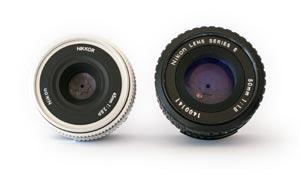Uhmmm, pancakes...
I always loved the look of the ultra-compact pancake lenses. Now I own two.
I think the first pancake lens I saw was in fact a Pentax, and for some reason Pentax seems to be leading the pack when it comes to offering pancake lenses. They currently have three lenses in the lineup, and definitely have the broadest selection ranging from a 21mm f/3.8 to a 70mm f/2.4 with a 40mm f/2.8 in between. Canon has a 40mm f/2.8 and Sony has a 20mm f/2.8. A number of other manufacturers also make compact, pancake-style lenses, and if you start looking to other systems than the large SLR's like the (Micro) 4/3 system, the selection is actually quite big, probably because making small lenses for these systems is easier than making them for large sensor cameras.
Nikon has had a number of pancake lenses in their lineup. Currently they have none, but both the 45mm f/2.8 and the 50mm f/1.8 are often available used, and these two are the ones I bought.
Now, these are manual lenses, and lack the facilities that come with modern Nikon glass. They both have aperture rings, they aren't G-lenses and are altogether somewhat primitive. On the other hand they are both very convincingly constructed and come from a time where lens barrels were made from metal and focus rings were smooth and well dampened.
The 50mm f/1.8 is an E-Series lens with an origin back in 1979, and has no electronics at all, so it's fully manual on the D5100 and aperture priority or manual on the D300s.
The 45mm f/2.8 is much newer, released in 2001, and has electronics and will meter on both the entry level cameras as well as their bigger brethren.
There's also an even older Nikkor GN Auto 45mm F2.8 Non AI, which is seen now and then. This lens was introduced in 1969.
Should anybody want to know: these lenses are all fit for fullframe bodies, coming from an era before anybody had ever thought of DX. I use them on my DX bodies, and of course they work nicely there, just acting as lenses with a 1.5 times longer focal length - 67.5mm for the 45mm and 75mm for the 50mm.
The older 50mm model is dirt cheap, and can easily be found as low as 50 US$. The 45mm is way more expensive, and mint copies with lids and the special hood can easily go for 3-400 US$ even though less expensive specimens can almost always be found.
I was in all aspects well covered in the focal range of these lenses already, and can't say that I bought them out of any kind of need. They don't outshine anything I have already, but certainly both do an excellent job, rendering sharp and nice images. They aren't that impressing, but I still love to mount them on my cameras for the look, and feel that smooth sensation when I focus manually. The silver 45mm looks especially charming on my old school Nikon FE2 film body with its silver and black finish.
Not rational.
Not sensible.
Not logical.
But very nice...




